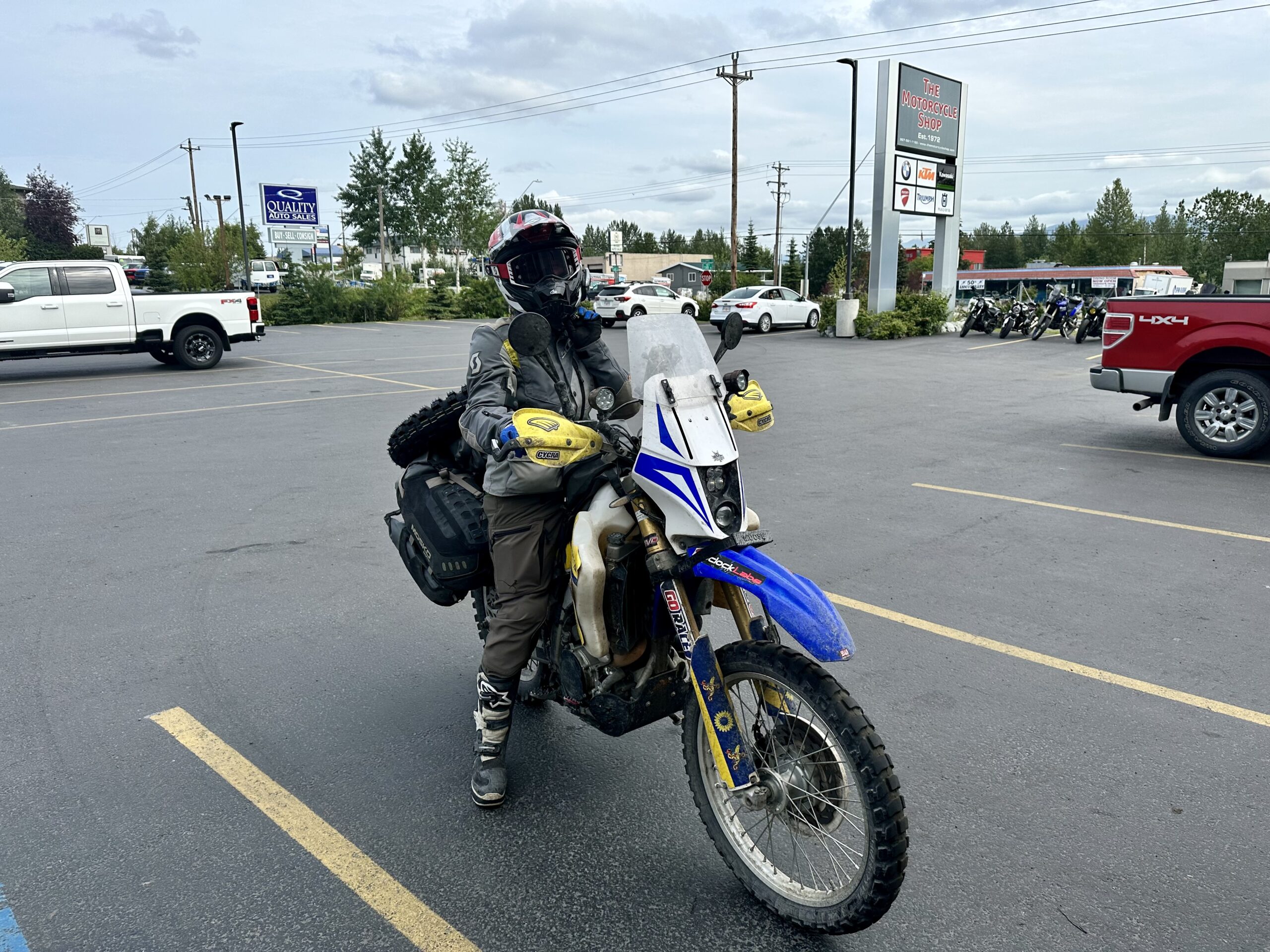The rain continued, and our freshly dry boots promptly got soaked again as we headed further south past Anchorage. It was gloomy, cloudy and very windy. We kept riding on the Seward Highway around Turnagain Arm and the views, although limited, were stunning. We couldn’t see the mountains and glaciers that surrounded us, but that allowed us to focus on the immense tidal mud flats of the arm. Apparently, the tides here reach over 10 meters and sometimes create a long wave the locals have been known to surf on. There are many scenic pullouts to enjoy the views along the highway, and if it wasn’t for the crazy wind, we would have loved to spend more time here.
Aside from the boots, which are just regular MX boots and focus on breathability rather than waterproofness, the rest of our gear was technically waterproof. We wore rain shells over our jackets and pants, and GoreTex gloves. Well, after 4 hours of riding in the incessant rain, water found a way almost everywhere. My biggest disappointment were the gloves. After a few hours I started to feel cold and wet in my fingertips, and soon enough the gloves were somehow soaked. We were going to stay with our new friends in Homer, at the tip of the Kenai peninsula, and stopped at a shop along the way to get some beer. As I walked up to the cashier to pay, she demanded to see my ID and to take off my helmet for verification. Seriously? I pleaded that it’s a lot more difficult than usual for me to dig my wallet from underneath the waterproofs and remove and put back again my helmet, but she was strict. As I pulled off my wet glove, its various layers began to separate and it was a mess that only got worse later on.
Near Soldotna the rain shifted into thick fog with visibility reduced to just a couple of meters. We were counting down how much longer until we would reach Homer. Once there, Andy and Christine welcomed us into a separate cabin, located next to a new house they were building. There was a wood stove for heat and we promptly got busy arranging our wet layers around the cabin to dry.
Back in the new house, we were also joined by their super energetic dog, Slim. He was pretty big, but acted like a puppy. We chatted for a long time about the quirks of living in Alaska, since our hosts were also transplants from elsewhere in the US. Infrastructure work is crazy expensive here. Their house is in the hills away from the center of town, and although there is an electrical substation just 200 meters away, it would be prohibitively expensive to connect the house to the grid. Since they plan to only live here during the summers, solar power is proving sufficient. In fact, they even found a Quebec based company that makes DC powered appliances, specifically for off the grid living, and have all the usual comforts like a fridge and a microwave. It’s very useful to not have to lose energy to DC-AC converters.
In the morning a pair of native Alaskans paid us a visit – a moose with her calf. The rain had stopped, although the skies were still overcast. It looked good enough to go out and explore the town and its surroundings.
There are a couple of notable things to check out in the area. First is the Homer Spit. It’s a 7 km long narrow piece of land stretching from town into the bay. At first I thought it was an artificial spit, created to support the ferry service, which departs from its far end to destinations on the Alaska Marine Highway System. No, Homer Spit is natural and there is more than one theory as to its creation. In practical terms, it functions as a tourist hub of the town, with many shops and cafes as well as a long stretch of walkable beach.
Properly caffeinated at the split, we headed to check out the second type of local landmark – old Russian villages. Following East End Road further east out of Homer, we eventually turned on a gravel covered road leading to Razdolna, a tiny village that seemed awfully quiet on this gray day, although by no means abandoned looking. We came back to East End Road and followed it further and further, to an equally empty village of Voznesenka.
Situated on an almost 200 meter tall ridge, the village marked the end of the main road. Past this point it turned into dirt and descended fairly rapidly towards the sea. At the beach the road straightened out and continued for many kilometers further. We passed a turn off towards another Russian village, this time with a sign that said in no uncertain terms that uninvited visitors are not welcome. We passed a car and asked the driver why are all the villages so empty, where were all the people? He smiled and in an unusual flavor of Russian replied that everyone is out fishing. Of course. The salmon dipnetting season was open and would only last 2 more weeks, with the high grocery prices, everyone takes the opportunity to stock up their freezers while they can.
Continuing along the beach road, I stopped, mesmerized at the enormous number of swallows flying around in one area. The clay soil of the bluff was perfect for their nests, and they kept coming and going accompanied by the chirping noises. One bird stood out – it was stuck, wing caught in a splintered dry branch. Alex climbed the bluff and carefully freed the bird, gave it a calming hug, and let it out. Thankfully the little swallow appeared unharmed, stuttered for a moment and then flew away happily.




























